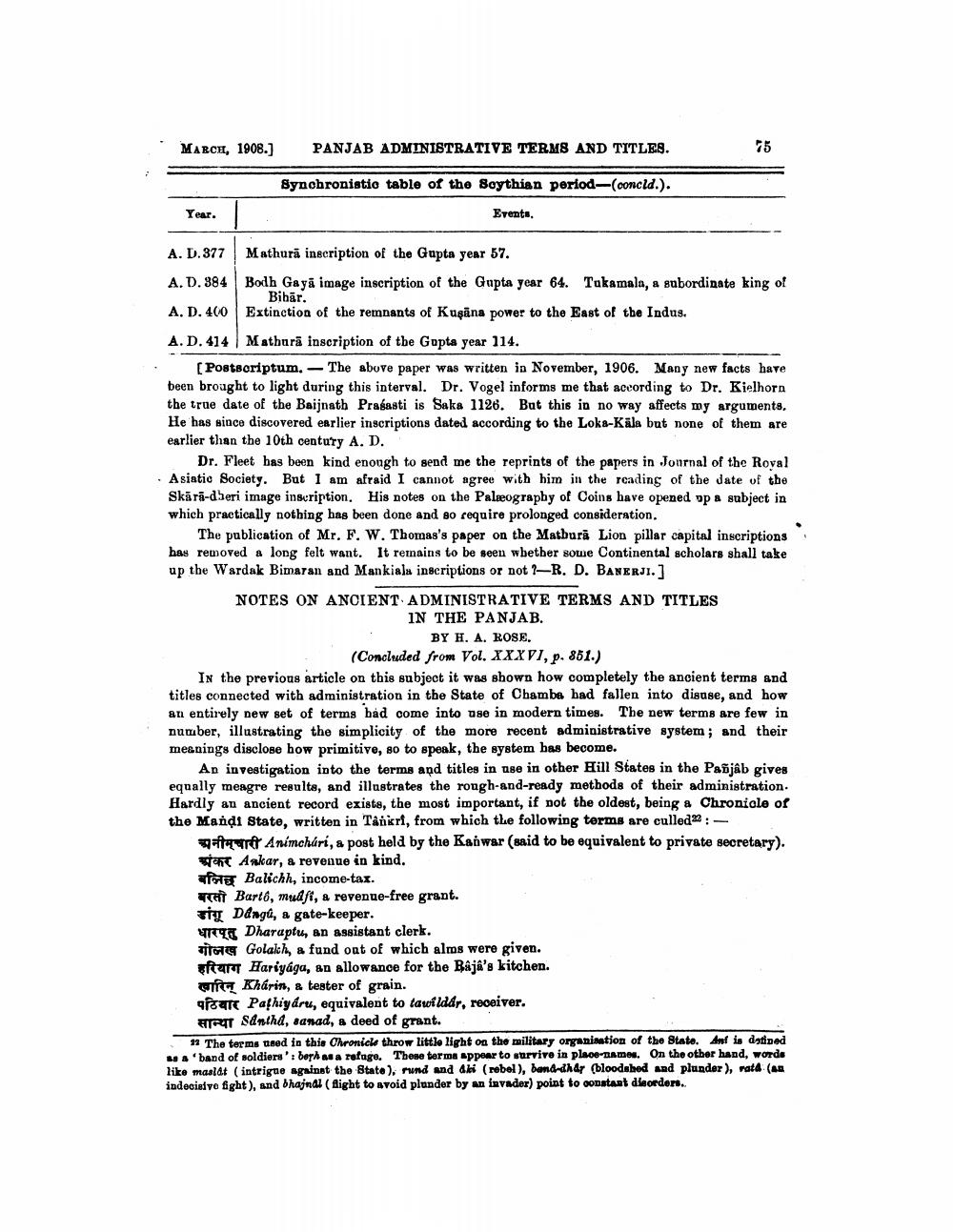________________
MARCH, 1908.)
PANJAB ADMINISTRATIVE TERMS AND TITLES.
Synchronistio table of the Soythian period-concld.).
Year.
Events
A. D.377 Mathurā inscription of the Gupta year 57. A. D.384 Bodh Gayā image inscription of the Gupta year 64. Tukamala, a subordinate king of
Bihar. A. D. 400 Extinction of the remnants of Kuşāna power to the East of the Indus. A. D. 414 | Mathurā inscription of the Gupta year 114.
(Postscriptum. - The above paper was written in November, 1906. Many new facts have been brought to light during this interval. Dr. Vogel informs me that according to Dr. Kielhorn the true date of the Baijnath Prasasti is Saka 1126. But this in no way affects my arguments, He has since discovered earlier inscriptions dated according to the Loka-Kāla but none of them are earlier than the 10th century A. D.
Dr. Fleet bas been kind enough to send me the reprints of the papers in Journal of the Royal Asiatic Society. But I am afraid I cannot agree with him in the reading of the date of the Skārā-dberi image inscription. His notes on the Palæography of Coins have opened up a subject in which practically nothing has been done and so require prolonged consideration.
The publication of Mr. F. W. Thomas's paper on the Matbura Lion pillar capital inscriptions has removed a long felt want. It remains to be seen whether some Continental scholars shall take up the Wardak Bimaran and Mankiala inscriptions or not?—R. D. BANERJI. ] NOTES ON ANCIENT ADMINISTRATIVE TERMS AND TITLES
IN THE PANJAB.
BY H. A. ROSE.
(Concluded from Vol. XXXVI, p. 851.) In the previous article on this subject it was shown how completely the ancient terms and titles connected with administration in the State of Chamba had fallen into disuse, and how an entirely new set of terms had come into use in modern times. The new terms are few in number, illustrating the simplicity of the more recent administrative system; and their meanings disclose how primitive, so to speak, the system has become.
An investigation into the terms and titles in use in other Hill States in the Pañjab gives equally meagre results, and illustrates the rough-and-ready methods of their administration. Hardly an ancient record exists, the most important, if not the oldest, being a Chronicle of the Mandi State, written in Tankri, from which the following terms are culled22 : -
qaftar Animchári, a post held by the Kanwar (said to be equivalent to private secretary). i Ankar, & revenue in kind. fota Balichh, income-tax.
a Bartó, muafi, & revenue-free grant. sty Dangú, a gate-keeper. FIT Dharaptu, an assistant clerk.
og Golakh, a fund out of which alms were given. gtart Hariyaga, an allowance for the Raja's kitchen.
a Khárin, & teater of grain. aftar Pathiy dru, equivalent to tawilddr, receiver. FeaT santha, sanad, a deed of grant.
12 The terms tined in this Chronicle throw little light on the military organisation of the State. Anf is datided as a 'band of soldiers': both as a rofage. These terms appear to survive in place dames. On the other hand, words liko maslat (intrigue against the Btato), rund and abi (rebel), band-thdr (bloodshed and plunder), rata (An indecisiyo fight), and bhajndl (Aight to avoid plunder by an invader) point to constant dieorders..




